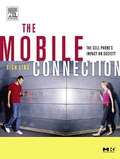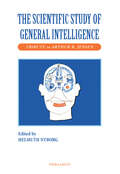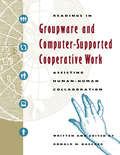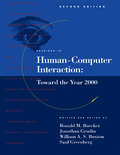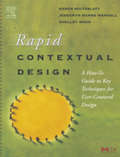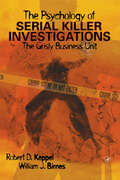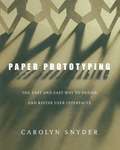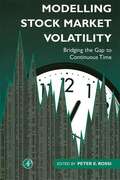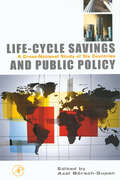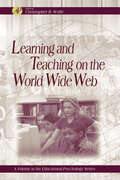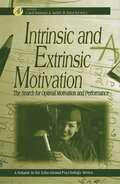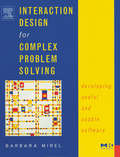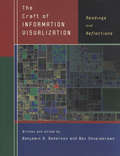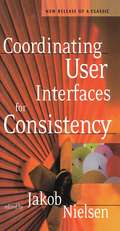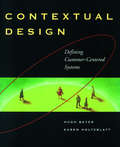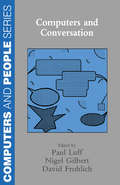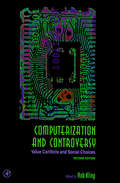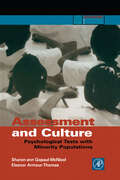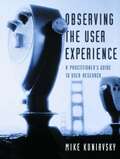- Table View
- List View
The Mobile Connection: The Cell Phone's Impact on Society (Interactive Technologies)
by Rich LingHas the cell phone forever changed the way people communicate? The mobile phone is used for “real time" coordination while on the run, adolescents use it to manage their freedom, and teens “text" to each other day and night. The mobile phone is more than a simple technical innovation or social fad, more than just an intrusion on polite society. This book, based on world-wide research involving tens of thousands of interviews and contextual observations, looks into the impact of the phone on our daily lives. The mobile phone has fundamentally affected our accessibility, safety and security, coordination of social and business activities, and use of public places. Based on research conducted in dozens of countries, this insightful and entertaining book examines the once unexpected interaction between humans and cell phones, and between humans, period. The compelling discussion and projections about the future of the telephone should give designers everywhere a more informed practice and process, and provide researchers with new ideas to last years.*Rich Ling (an American working in Norway) is a prominent researcher, interviewed in the new technology article in the November 9 issue of the New York Times Magazine. *A particularly "good read", this book will be important to the designers, information designers, social psychologists, and others who will have an impact on the development of the new third generation of mobile telephones. *Carefully and wittily written by a senior research scientist at Telenor, Norway's largest telecommunications company, and developer of the first mobile telephone system that allowed for international roaming.
The Scientific Study of General Intelligence: Tribute to Arthur Jensen
by Helmuth NyborgThis book celebrates two triumphs in modern psychology: the successful development and application of a solid measure of general intelligence; and the personal courage and skills of the man who made this possible - Arthur R. Jensen from Berkeley University. The volume traces the history of intelligence from the early 19th century approaches, to the most recent analyses of the hierarchical structure of cognitive abilities, and documents the transition from a hopelessly confused concept of intelligence to the development of an objective measure of psychometric g. The contributions illustrate the impressive power g has with respect to predicting educational achievement, getting an attractive job, or social stratification. The book is divided into six parts as follows: Part I presents the most recent higher-stream analysis of cognitive abilities, Part II deals with biological aspects of g, such as research on brain imaging, glucose uptake, working memory, reaction time, inspection time, and other biological correlates, and concludes with the latest findings in g-related molecular genetics. Part III addresses demographic aspects of g, such as geographic-, race-, and sex-differences, and introduces differential psychological aspects as well. Part IV concentrates on the g nexus, and relates such highly diverse topics as sociology, genius, retardation, training, education, jobs, and crime to g. Part V contains chapters critical of research on g and its genetic relationship, and also presents a rejoinder. Part VI looks at one of the greatest contemporary psychologists, Professor Emeritus Arthur R. Jensen as teacher and mentor.
Readings in Groupware and Computer-Supported Cooperative Work: Assisting Human-Human Collaboration (Interactive Technologies)
by Ronald M. BaeckerThis comprehensive introduction to the field represents the best of the published literature on groupware and computer-supported cooperative work (CSCW). The papers were chosen for their breadth of coverage of the field, their clarity of expression and presentation, their excellence in terms of technical innovation or behavioral insight, their historical significance, and their utility as sources for further reading. Taken as a whole, the papers and their introductions are a complete sourcebook to the field. This book will be useful for computer professionals involved in the development or purchase of groupware technology as well as for researchers and managers. It should also serve as a valuable text for university courses on CSCW, groupware, and human-computer interaction.
Readings in Human-Computer Interaction: Toward the Year 2000 (Interactive Technologies)
by Ronald M. BaeckerThe effectiveness of the user-computer interface has become increasingly important as computer systems have become useful tools for persons not trained in computer science. In fact, the interface is often the most important factor in the success or failure of any computer system. Dealing with the numerous subtly interrelated issues and technical, behavioral, and aesthetic considerations consumes a large and increasing share of development time and a corresponding percentage of the total code for any given application. A revision of one of the most successful books on human-computer interaction, this compilation gives students, researchers, and practitioners an overview of the significant concepts and results in the field and a comprehensive guide to the research literature. Like the first edition, this book combines reprints of key research papers and case studies with synthesizing survey material and analysis by the editors. It is significantly reorganized, updated, and enhanced; over 90% of the papers are new. An invaluable resource for systems designers, cognitive scientists, computer scientists, managers, and anyone concerned with the effectiveness of user-computer interfaces, it is also designed for use as a primary or supplementary text for graduate and advanced undergraduate courses in human-computer interaction and interface design.Human computer interaction--historical, intellectual, and socialDeveloping interactive systems, including design, evaluation methods, and development toolsThe interaction experience, through a variety of sensory modalities including vision, touch, gesture, audition, speech, and languageTheories of information processing and issues of human-computer fit and adaptation
Rapid Contextual Design: A How-to Guide to Key Techniques for User-Centered Design (Interactive Technologies)
by Shelley Wood Karen Holtzblatt Jessamyn Burns WendellIs it impossible to schedule enough time to include users in your design process? Is it difficult to incorporate elaborate user-centered design techniques into your own standard design practices? Do the resources needed seem overwhelming? This handbook introduces Rapid CD, a fast-paced, adaptive form of Contextual Design. Rapid CD is a hands-on guide for anyone who needs practical guidance on how to use the Contextual Design process and adapt it to tactical projects with tight timelines and resources. Rapid Contextual Design provides detailed suggestions on structuring the project and customer interviews, conducting interviews, and running interpretation sessions. The handbook walks you step-by-step through organizing the data so you can see your key issues, along with visioning new solutions, storyboarding to work out the details, and paper prototype interviewing to iterate the design—all with as little as a two-person team with only a few weeks to spare!Includes real project examples with actual customer data that illustrate how a CD project actually worksCovers the entire scope of a project, from deciding on the number and type of interviews, to interview set up and analyzing collected data. Sample project schedules are also included for a variety of different types of projectsProvides examples of how-to write affinity notes and affinity labels, build an affinity diagram, and step-by-step instructions for consolidating sequence modelsShows how to use consolidated data to define a design within tight time frames with examples of visions, storyboards, and paper prototypesIntroduces CDTools™, the first application designed to support customer-centered design
The Psychology of Serial Killer Investigations: The Grisly Business Unit
by William J. Birnes Robert D. KeppelSerial killers like Seattle's Ted Bundy, Maryland's Beltway Sniper, Atlanta's Wayne Williams, or England's Peter Sutcliffe usually outsmart the task forces on their trail for long periods of time. Keppel and Birnes take readers inside the operations of serial killer task forces to learn why. What is the underlying psychology of a serial killer and why this defeats task force investigations? This is the first book of its kind that combines state-of-the-art psychological assessment experience with the expertise of a homicide investigator who has tracked some of this country's most notorious serial killers. The author also brings to the book hands-on best practices gleaned from the experience of other task forces. Readers, both professionals and students, will benefit from the comprehensive and critical case reviews, the analysis of what went wrong, what went right, and the after-action recommendations of evaluators in the US, UK, and Canada. The book covers: * The nature of the psychology of a serial killer * How crime assessment profiling reveals that psychology * Why psychological profiles fail * How serial killer task forces defeat themselves * How the media can, and usually does, undermine the task force operation * The big secret of all serial killer investigations: police already have the killer's name * The best practices for catching a serial killer* Comprehensive case reviews of some of the US's and UK's most baffling serial killer cases * A list of best practices for serial killer task force investigators * Recommendations for how to manage comprehensive files and computer records* Practical advice on how to manage the media: what to say and not to say* Insight into what a serial killer might be thinking and doing to stay away from police* Recommendations for setting up and administering long-term investigations* Practical tips on how to maintain a task force's psychological edge and avoid defeatism
Paper Prototyping: The Fast and Easy Way to Design and Refine User Interfaces (Interactive Technologies)
by Carolyn SnyderDo you spend a lot of time during the design process wondering what users really need? Do you hate those endless meetings where you argue how the interface should work? Have you ever developed something that later had to be completely redesigned? Paper Prototyping can help. Written by a usability engineer with a long and successful paper prototyping history, this book is a practical, how-to guide that will prepare you to create and test paper prototypes of all kinds of user interfaces. You'll see how to simulate various kinds of interface elements and interactions. You'll learn about the practical aspects of paper prototyping, such as deciding when the technique is appropriate, scheduling the activities, and handling the skepticism of others in your organization. Numerous case studies and images throughout the book show you real world examples of paper prototyping at work. Learn how to use this powerful technique to develop products that are more useful, intuitive, efficient, and pleasing: * Save time and money - solve key problems before implementation begins * Get user feedback early - use it to focus the development process * Communicate better - involve development team members from a variety of disciplines * Be more creative - experiment with many ideas before committing to one*Enables designers to solve design problems before implementation begins *Five case studies provide real world examples of paper prototyping at work *Delves into the specifics of what types of projects paper prototyping is and isn't good for.
Modelling Stock Market Volatility: Bridging the Gap to Continuous Time
by Peter E. RossiThis essay collection focuses on the relationship between continuous time models and Autoregressive Conditionally Heteroskedastic (ARCH) models and applications. For the first time, Modelling Stock Market Volatility provides new insights about the links between these two models and new work on practical estimation methods for continuous time models. Featuring the pioneering scholarship of Daniel Nelson, the text presents research about the discrete time model, continuous time limits and optimal filtering of ARCH models, and the specification and estimation of continuous time processes. This work will lead to a rapid growth in their empirical application as they are increasingly subjected to routine specification testing. Provides for the first time new insights on the links between continuous time and ARCH models Collects seminal scholarship by some of the most renowned researchers in finance and econometrics Captures complex arguments underlying the approximation and proper statistical modelling of continuous time volatility dynamics
Life-Cycle Savings and Public Policy: A Cross-National Study of Six Countries
by Axel Borsch-SupanLife-Cycle Savings and Public Policy examines data on many households from a number of different countries. The hope is that through these observations we can learn about the ways policies affect savings, and that other differences among savers can be controlled for, instead of being blamed on cultural differences. This book features a consistent framework among chapters. It reaches a harmony between measurement and analysis to compare accurately the resulting data and statistics. It provides econometric methodology to reveal the way policies affect savings. The book features data on household savings in Germany, Italy, Japan, the Netherlands, the U.K., and the U.S. This book is recommended reading for anyone interested in saving, social insurance policy, or capital formation. Features a consistent framework among chaptersReaches a harmony between measurement and analysis to compare accurately the resulting data and statisticsProvides econometric methodology to reveal the way policies affect savings
Learning and Teaching on the World Wide Web (ISSN #Volume -)
by Christopher R. WolfeThis book is about using the Internet as a teaching tool. It starts with the psychology of the learner and looks at how best to fit technology to the student, rather than the other way around. The authors include leading authorities in many areas of psychology, and the book takes a broad look at learners as people. Thus, it includes a wide range of materials from how the eye "reads" moving graphs on a Web page to how people who have never met face-to-face can interact on the Internet and create "communities" of learners. The book considers many Internet technologies, but focuses on the World Wide Web and new "hybrid" technologies that integrate the Web with other communications technologies. This book is essential to researchers is psychology and education who are interested in learning. It is also used in college and graduate courses in departments of psychology and educational psychology. Teachers and trainers at any level who are using technology in their teaching (or thinking about it) find this book very useful.Key Features* Distinguished authors with considerable expertise in their fields* Broad "intra-disciplinary" perspective on learning and teaching on the Web* Focus on the Web and emerging Web-based technologies* Special attention to conducting educational research on-line* Emphasis on the Social and Psychological Context* Analyses of effective Web-based learning resources* Firmly grounded in contemporary psychological research and theory
Intrinsic and Extrinsic Motivation: The Search for Optimal Motivation and Performance (ISSN)
by Judith M. Harackiewicz Carol SansoneIn understanding human behavior, psychologists have long been interested in what motivates specific actions. Debates have pitted extrinsic motivators (e.g. rewards/punishment) against intrinsic motivation in attempting to determine what best motivates individuals. This book provides a summary view of what research has determined about both extrinsic and intrinsic motivation, and clarifies what questions remain unanswered. Divided into three sections, section I revisits the debate about the effects of extrinsic incentives or constraints on intrinsic motivation and creativity, and identifies theoretical advances in motivational research. Section II focuses on the hidden costs and benefits of different types of achievement goals on motivation and performance. Section III discusses theory and research findings on how extrinsic and intrinsic motivators may work in everyday life and over time. This book is of interest to researchers in psychology, education, and business, as well as to a wider audience interested in promoting optimal motivation and performance.Coverage in this book includes:* Debates and controversies in motivational research* Developmental nature of intrinsic and extrinsic motivation over time* Influences of parents, educators, and employers in facilitating motivation* Effect of achievement goals on learning and performance* The role of intrinsic and extrinsic motivation in self-regulationKey Features* Brings together major figures in the fields of motivation, education, and social psychology* Provides a mix of theory, basic and applied research* Presents research conducted both in laboratories and educational settings* Comprehensive chapters provide excellent reviews of previous literature as well as outlines important new directions* Provides different perspectives on controversial debates in a balanced, constructive manner
Interaction Design for Complex Problem Solving: Developing Useful and Usable Software (Interactive Technologies)
by Barbara MirelSoftware for complex problem solving can dazzle people with advanced features and alluring visuals, but when actually put to use it often disappoints and even frustrates users. This software rarely follows the user's own work methods, nor does it give people the degree of control and choice that they truly need.This book presents a groundbreaking approach to interaction design for complex problem solving applications. The author uses her vast field experience to present a new way of looking at the whole process, and treats complex problem solving software and web applications as a distinct class with its own set of usefulness demands and design criteria. This approach highlights integrated interactions rather than discrete actions, clearly defines what makes problem solving complex, and explores strategies for analyzing, modeling, and designing for exploratory inquiries.·In depth case studies ranging from IT troubleshooting to marketing analysis to risk assessments in healthcare show exactly where and what goes wrong in real world activities and how to improve them.·Presents a system and framework for analyzing complex work and takes the mystery out of eliciting patterns of work and their meanings.·Offers new perspectives for support and new design strategies for building the right models into programs so that they effectively address users' dynamic work. ·Allows designers to turn findings into useful designs for problems that require users to create new knowledge but with no one right answer and with many methods of reaching solutions.
The Craft of Information Visualization: Readings and Reflections (Interactive Technologies)
by Ben Shneiderman Benjamin B. BedersonSince the beginning of the computer age, researchers from many disciplines have sought to facilitate people's use of computers and to provide ways for scientists to make sense of the immense quantities of data coming out of them. One gainful result of these efforts has been the field of information visualization, whose technology is increasingly applied in scientific research, digital libraries, data mining, financial data analysis, market studies, manufacturing production control, and data discovery.This book collects 38 of the key papers on information visualization from a leading and prominent research lab, the University of Maryland’s Human-Computer Interaction Lab (HCIL). Celebrating HCIL’s 20th anniversary, this book presents a coherent body of work from a respected community that has had many success stories with its research and commercial spin-offs. Each chapter contains an introduction specifically written for this volume by two leading HCI researchers, to describe the connections among those papers and reveal HCIL’s individual approach to developing innovations.*Presents key ideas, novel interfaces, and major applications of information visualization tools, embedded in inspirational prototypes.*Techniques can be widely applied in scientific research, digital libraries, data mining, financial data analysis, business market studies, manufacturing production control, drug discovery, and genomic studies.*Provides an "insider" view to the scientific process and evolution of innovation, as told by the researchers themselves.*This work comes from the prominent and high profile University of Maryland's Human Computer Interaction Lab
Coordinating User Interfaces for Consistency (Interactive Technologies)
by Jakob NielsenIn the years since Jakob Nielsen's classic collection on interface consistency first appeared, much has changed, and much has stayed the same. On the one hand, there's been exponential growth in the opportunities for following or disregarding the principles of interface consistency-more computers, more applications, more users, and of course the vast expanse of the Web. On the other, there are the principles themselves, as persistent and as valuable as ever. In these contributed chapters, you'll find details on many methods for seeking and enforcing consistency, along with bottom-line analyses of its benefits and some warnings about its possible dangers. Most of what you'll learn applies equally to hardware and software development, and all of it holds real benefits for both your organization and your users.Begins with a new preface by the collection's distinguished editorDetails a variety of methods for attaining interface consistency, including central control, user definitions, exemplary applications, shared code, and model analysisPresents a cost-benefits analysis of organizational efforts to promote and achieve consistencyExamines and appraises the dimensions of consistency-consistency within an application, across a family of applications, and beyondMakes the case for some unexpected benefits of interface consistency while helping you avoid the risks it can sometimes entailConsiders the consistency of interface elements other than screen designIncludes case studies of major corporations that have instituted programs to ensure the consistency of their products
Contextual Design: Defining Customer-Centered Systems (Interactive Technologies)
by Karen Holtzblatt Hugh BeyerThis book introduces a customer-centered approach to business by showing how data gathered from people while they work can drive the definition of a product or process while supporting the needs of teams and their organizations. This is a practical, hands-on guide for anyone trying to design systems that reflect the way customers want to do their work. The authors developed Contextual Design, the method discussed here, through their work with teams struggling to design products and internal systems. In this book, you'll find the underlying principles of the method and how to apply them to different problems, constraints, and organizational situations.Contextual Design enables you to+ gather detailed data about how people work and use systems + develop a coherent picture of a whole customer population + generate systems designs from a knowledge of customer work+ diagram a set of existing systems, showing their relationships, inconsistencies, redundancies, and omissions
Computers and Conversation
by Paul Luff David Frohlich Nigel G. GilbertIn the past few years a branch of sociology, conversation analysis, has begun to have a significant impact on the design of human*b1computer interaction (HCI). The investigation of human*b1human dialogue has emerged as a fruitful foundation for interactive system design.****This book includes eleven original chapters by leading researchers who are applying conversation analysis to HCI. The fundamentals of conversation analysis are outlined, a number of systems are described, and a critical view of their value for HCI is offered.****Computers and Conversation will be of interest to all concerned with HCI issues--from the advanced student to the professional computer scientist involved in the design and specification of interactive systems.
Computerization and Controversy: Value Conflicts and Social Choices
by Rob KlingThe Second Edition of Computerization and Controversy: Value Conflicts and Social Choices is a collection of 78 articles that examine the social aspects of computerization from a variety of perspectives, many presenting important viewpoints not often discussed in the conventional literature. A number of paired articles comprise thought-provoking head-on debate. Fields represented include computer science, information systems, management, journalism, psychology, law, library science, and sociology. This volume introduces some of the major controversies surrounding the computerization of society and helps readers recognize the social processes that drive and shape computerization. Division into eight provocatively titled sections facilitates course planning for classroom or seminar use. A lead article for each section frames the major controversies, locates the selections within the debates, and points to other relevant literature.A fully revised and updated version of the first anthological treatment of the subjectOrganized to facilitate course planning for classroom or seminar useProvides coverage of the influence of computers on a wide variety of fields including computer science, information systems, management, journalism, psychology, law, library science, and sociology
Assessment and Culture: Psychological Tests with Minority Populations (ISSN)
by Sharon-ann Gopaul McNicol Eleanor Armour-ThomasAssessment and Culture challenges the classical approach to the assessment of minority populations by pointing out the deficiencies in this approach and offers instead a bio-cultural model of assessment. The principle objective of this book is to help mental health professionals to more accurately assess individuals from various ethnic, cultural and linguistic backgrounds. The culture-fair techniques and strategies of the book tap into a broad range of the abilities and aptitudes of the examinee. Assessment and Culture provides a cultural frame of reference which allows the examiner to take into account the individual's social and cultural factors in development, coping style and personal history. Individual chapters consider the practical aspects of assessing the intellectual, linguistic, academic, visual-motor, emotional and vocational functioning of culturally diverse children. An entire section of the book is devoted to writing the assessment report.
Research in Organizational Behavior (ISSN #Volume 25)
by Roderick M. Kramer Barry StawThis volume celebrates the first quarter century of publishing Research in Organizational Behavior. From its inception, Research in Organizational Behavior has striven to provide important theoretical integrations of major literatures in the organizational sciences, as well as timely examination and provocative analyses of pressing organizational issues and problems. In keeping with this tradition, the current volume offers an eclectic mix of scholarly articles that address a variety of important questions in organizational theory and do so from a diverse range of disciplinary perspectives and theoretical orientations. A number of the chapters also directly engage contemporary events and dilemmas of considerable importance.
Observing the User Experience: A Practitioner's Guide to User Research
by Mike KuniavskyThe gap between who designers and developers imagine their users are, and who those users really are can be the biggest problem with product development. Observing the User Experience will help you bridge that gap to understand what your users want and need from your product, and whether they'll be able to use what you've created. Filled with real-world experience and a wealth of practical information, this book presents a complete toolbox of techniques to help designers and developers see through the eyes of their users. It provides in-depth coverage of 13 user experience research techniques that will provide a basis for developing better products, whether they're Web, software or mobile based. In addition, it's written with an understanding of how software is developed in the real world, taking tight budgets, short schedules, and existing processes into account.·Explains how to create usable products that are still original, creative, and unique·A valuable resource for designers, developers, project managers—anyone in a position where their work comes in direct contact with the end user.·Provides a real-world perspective on research and provides advice about how user research can be done cheaply, quickly and how results can be presented persuasively·Gives readers the tools and confidence to perform user research on their own designs and tune their software user experience to the unique needs of their product and its users
Handbook of Forensic Psychology: Resource for Mental Health and Legal Professionals
by William O'Donohue Eric R. LevenskyForensic psychology has mushroomed into a diverse and increasingly complex field that is equal parts law and psychology. Psychologists act as expert witnesses in legal cases - sometimes without knowing much about the laws involved, and legal professionals rely on the assessment of psychologists sometimes without knowing much about how such assessments are made. The purpose of this handbook is to provide professionals with current, practical, and empirically based information to guide their work in forensic settings, or to better their understanding of the issues and debates in forensic psychology.Divided into four sections, the Handbook of Forensic Psychology covers basic issues, assessment, mental disorders and forensic psychology, and special topics. The basic issue chapters present a primer on law for the psychologist, a primer on psychology for attorneys, an overview of ethical issues relevant to forensic psychology, and a chapter on forensic report writing. The assessment section discusses factors and measures relevant for assessing a variety of behaviors, propensities, and capabilities, including dangerousness, violence, suicide, competency, substance abuse, PTSD and neuropsychological evaluations, as well as discussing interviewing children and child custody evaluations. Additional chapters discuss eyewitness testimony, recovered memory, polygraphs, sexual harassment, juror selection, and issues of ethnicity in forensic psychology.
Handbook of Multicultural Mental Health: Assessment and Treatment of Diverse Populations
by Freddy A. PaniaguaClinicians and mental health practitioners are regularly called upon to treat patients of diverse cultural and ethnic backgrounds. Not only do these patients differ from Anglos in culture and language, but also in customs, beliefs, values, and practices. Understanding these differences is vital to performing an accurate diagnosis/assessment of psychopathology as well as in determining an effective treatment regimen.This book provides vital information to clinicians worldwide in bettering their treatment of diverse populations. Each chapter identifies relevant cultural variables specific to each racial/ethnic group, along with ethnocultural measures and their relevant psychometric properties. Part 1 presents introductory material on the definition of mental illness and pathological behavior in differing cultures, epidemiological data on the prevalence of different disorders between differing population groups, culture specific beliefs (e.g. hexes), and the influence of culture on treatment. Part 2 discusses assessment issues including how specific measures (Rorschach, MMPI, etc.) are best interpreted with different population groups, and the existence and use of ethnocultural specific measures. Part 3 discusses assessment and treatment of specific population groups (e.g., Indians, Asians, Latinos, etc.).
HCI Models, Theories, and Frameworks: Toward a Multidisciplinary Science (Interactive Technologies)
by John M. CarrollHCI Models, Theories, and Frameworks provides a thorough pedagological survey of the science of Human-Computer Interaction (HCI). HCI spans many disciplines and professions, including anthropology, cognitive psychology, computer graphics, graphical design, human factors engineering, interaction design, sociology, and software engineering. While many books and courses now address HCI technology and application areas, none has addressed HCI’s multidisciplinary foundations with much scope or depth. This text fills a huge void in the university education and training of HCI students as well as in the lifelong learning and professional development of HCI practitioners. Contributors are leading researchers in the field of HCI. If you teach a second course in HCI, you should consider this book. This book provides a comprehensive understanding of the HCI concepts and methods in use today, presenting enough comparative detail to make primary sources more accessible. Chapters are formatted to facilitate comparisons among the various HCI models. Each chapter focuses on a different level of scientific analysis or approach, but all in an identical format, facilitating comparison and contrast of the various HCI models. Each approach is described in terms of its roots, motivation, and type of HCI problems it typically addresses. The approach is then compared with its nearest neighbors, illustrated in a paradigmatic application, and analyzed in terms of its future. This book is essential reading for professionals, educators, and students in HCI who want to gain a better understanding of the theoretical bases of HCI, and who will make use of a good background, refresher, reference to the field and/or index to the literature.Contributors are leading researchers in the field of Human-Comptuter Interaction Fills a major gap in current literature about the rich scientific foundations of HCI Provides a thorough pedogological survey of the science of HCI
Development of Achievement Motivation (ISSN #Volume .)
by Allan Wigfield Jacquelynne S. EcclesThis book discusses research and theory on how motivation changes as children progress through school, gender differences in motivation, and motivational differences as an aspect of ethnicity. Motivation is discussed within the context of school achievement as well as athletic and musical performance.Key Features* Coverage of the major theories and constructs in the motivation field* Focus on developmental issues across the elementary and secondary school period* Discussion of instructional and theoretical issues regarding motivation* Consideration of gender and ethnic differences in motivation
Text Entry Systems: Mobility, Accessibility, Universality
by I. Scott MacKenzie Kumiko Tanaka-IshiiText Entry Systems covers different aspects of text entry systems and offers prospective researchers and developers global guidelines for conducting research on text entry, in terms of design strategy, evaluation methodology, and requirements; a discussion of the history and current state of the art of entry systems; and specific guidelines for designing entry systems for a specific target, depending on devices, modalities, language, and different physical conditions of users. Text entry has never been so important as it is today. This is in large part due to the phenomenal, relatively recent success of mobile computing, text messaging on mobile phones, and the proliferation of small devices like the Blackberry and Palm Pilot. Compared with the recent past, when text entry was primarily through the standard "qwerty" keyboard, people today use a diverse array of devices with the number and variety of such devices ever increasing. The variety is not just in the devices, but also in the technologies used: entry modalities have become more varied and include speech recognition and synthesis, handwriting recognition, and even eye-tracking using image processing on web-cams. Statistical language modeling has advanced greatly in the past ten years and so therein is potential to facilitate and improve text entry — increasingly, the way people communicate.This book covers different aspects of text entry systems and offers prospective researchers and developersGlobal guidelines for conducting research on text entry, in terms of design strategy, evaluation methodology, and requirementsHistory and current state of the art of entry systems, including coverage of recent research topicsSpecific guidelines for designing entry systems for a specific target, depending on devices, modalities, language, and different physical conditions of users
